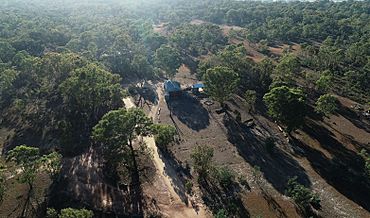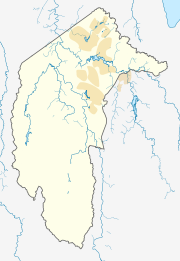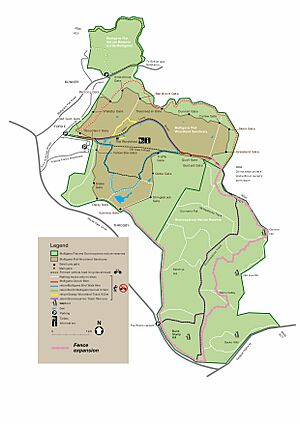Mulligans Flat Woodland Sanctuary facts for kids
Quick facts for kids Mulligans FlatAustralian Capital Territory |
|
|---|---|
|
IUCN Category IV (Habitat/Species Management Area)
|
|

Drone capture of Mulligans Flat by Alex Humphreys
|
|
| Established | 1994 |
| Area | 12.53 km² |
| Managing authorities | Woodlands and Wetlands Trust, ACT Government |
| Website | Mulligans Flat |
| See also | Australian Capital Territory protected areas |
The Mulligans Flat Woodland Sanctuary is a special protected area. You can find it in north Canberra, in the Australian Capital Territory. It used to be called Mulligans Flat Nature Reserve. This sanctuary has many trails for walking, running, and cycling. It's also a living laboratory where scientists study native plants and animals.
Contents
Exploring Mulligans Flat's Nature
Mulligans Flat is a mix of woodlands, open grassy areas, and a big dam. A special fox-proof fence surrounds part of the sanctuary. Even though this land was once used for farming, it wasn't farmed as heavily as other areas. This means its natural habitat is still in great shape.
Because of its unique and healthy environment, Mulligans Flat is a protected home for many threatened animals. These include the golden sun moth and the striped legless lizard. Many other plant and animal species also live here.
Trees and Wildflowers
You can find about 150 different kinds of wildflowers in the sanctuary. They grow under six types of gum trees. Some of these trees are very important, like the threatened Blakely's Red Gum (Eucalyptus blakelyi) and Yellow Box (Eucalyptus melliodora). These trees are perfect nesting spots for the vulnerable Superb Parrot.
Mulligans Flat is like a sister sanctuary to Zealandia Wildlife Sanctuary in New Zealand. The ACT Government manages it with help from the Woodlands and Wetlands Trust. They also help manage the nearby Jerrabomberra Wetlands.
A Look at Mulligans Flat's Past
Aboriginal History and Culture
Mulligans Flat is located on the traditional lands of the Ngunnawal people. This area has a rich history connected to Aboriginal culture.
An important Ngunnawal Songline (a traditional path or story) runs along Old Coach Road. This road is where Mulligans Flat meets Goorooyarroo. People have found old stone tools and scarred trees throughout the sanctuary. These show how Aboriginal people used the land for thousands of years.
Long ago, before European farming, the area had a steady water supply. This would have been a great place for a community to live. It offered plenty of food and resources. There's also a volcanic ridge to the east and a quartz ridge to the west. These ridges were important places for finding materials to make tools. These tools were used and traded by local people and travelers.
Today, Aboriginal people continue to care for the land at Mulligans Flat. They work with groups like the ACT Parks and Conservation Service's Aboriginal Ranger Program. The Traditional Owners Aboriginal Corporation (TOAC) sometimes holds educational sessions here. You can even find a "Welcome to Country" message in a self-guided walking tour App.
How the Sanctuary Began
In 1992, seven environmental groups suggested making Mulligans Flat a nature reserve. They wanted to protect it from city growth. People already knew the area was home to rare plants and animals. The Canberra Ornithologist's Group had even recorded six out of seven rare woodland bird species here.
So, in 1994, Mulligans Flat Nature Reserve became part of the Canberra Nature Park. Later, in 2004, protection was extended to Goorooyarroo Nature Reserve. In 2014, the Throsby Offsets also gained protection. More people got involved when the Friends of Mulligans Flat group started in 2011. Members can help with conservation work, like controlling weeds.
The Mulligans Flat-Goorooyarroo Woodland Experiment is a big project. It's a team effort between the ACT Government, CSIRO, and the Australian National University (ANU). They work together to bring back native species and restore habitats. They also study how different ways of managing the land affect the environment.
Protecting Mulligans Flat's Future
The sanctuary is often called an 'outdoor laboratory'. Its main goal is to help the ecosystem recover. This means bringing back more types of plants and animals and creating more healthy habitats.
Only about 30% of the original eucalyptus woodland remains here. But Mulligans Flat and Goorooyarroo together form the largest remaining area of White Box-Yellow Box-Blakely's Red Gum grassy woodland. This type of woodland is critically endangered in Australia.
In 2011, Mulligans Flat was given a special classification by the IUCN. It became a Category IV protected area. This means it's managed mainly for habitat and species protection.
The Fox-Proof Fence
A long, 11.5-kilometer fox-proof fence was built between 2008 and 2009. It protects 485 hectares of the sanctuary. After the fence was built, animals like rabbits, cats, and red foxes were removed. These animals are not native and harm the local wildlife. Mulligans Flat was the first Australian woodland reserve to successfully get rid of foxes and then rabbits.
In 2018, the fence was made even bigger. The protected area almost tripled to 1253 hectares. Other fences inside the sanctuary help researchers study kangaroos and bettongs. These smaller fences show how different management practices help the environment.
Bringing Back Native Animals
Many native animals have been brought back to Mulligans Flat. This work is often done with the ANU Fenner School.
The first animal successfully reintroduced was the eastern bettong (bettongia giamardi) in 2012. These small marsupials had been missing from mainland Australia for 80 years. Thirty-five bettongs were moved from Tasmania to the sanctuary. Scientists studied how bringing back this "ecosystem engineer" (an animal that shapes its environment) helped the habitat. Their research helped guide all future reintroductions.
Bush-stone curlews (burhinus grallarius) returned in 2014. They had been gone from the ACT for 40 years. Twelve birds were first kept in a special aviary inside Mulligans Flat. This helped them get used to their new home before being released. Some birds flew over the fence at first and were caught by foxes. So, for later releases, their flight feathers were clipped. This gave them more time to settle in. By the time their feathers grew back, they had made Mulligans Flat their permanent home.
In 2016, eastern quolls (dasyurus viverrinus) were also brought back. These animals had been locally extinct for about 80 years. Some quolls came from Tasmania, and others from a breeding program in Mt Rothwell, Victoria. Even though some quolls climbed over the fence, the remaining females had babies. This was the first time quolls had bred in Canberra in many years!
A second group of quolls was moved in 2017. More of these quolls survived and quickly settled into their new territory. They benefited from other restoration work, like adding more wood debris. This increased the number of insects, which are a food source for quolls. The presence of quolls from the first group also helped, as it showed the area was a good home.
Other species that have returned or are doing well in Mulligans Flat include the New Holland Mouse and the vulnerable Brown Tree-creeper. The New Holland mouse, like the eastern bettong, was locally extinct and has a captive bred population at ANU.
Images for kids




